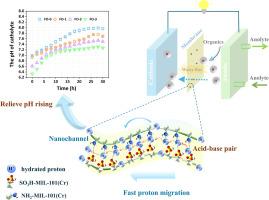当前位置:
X-MOL 学术
›
Water Res.
›
论文详情
Our official English website, www.x-mol.net, welcomes your
feedback! (Note: you will need to create a separate account there.)
Synergistic acceleration of proton migration in osmotic microbial fuel cell: hydrophilic nanochannels coupling acid-base pairs created by functionalized metal-organic frameworks in forward osmosis membrane
Water Research ( IF 11.4 ) Pub Date : 2025-05-31 , DOI: 10.1016/j.watres.2025.123927
Enling Tian, Yuan Liu, Cheng Song, Xingzu Wang, Fengjun Yin, Ling Fang, Shun Lu, Yu Lei, Hong Liu
Water Research ( IF 11.4 ) Pub Date : 2025-05-31 , DOI: 10.1016/j.watres.2025.123927
Enling Tian, Yuan Liu, Cheng Song, Xingzu Wang, Fengjun Yin, Ling Fang, Shun Lu, Yu Lei, Hong Liu

|
The sluggish migration of proton from anode to cathode poses a significant challenge in osmotic microbial fuel cell (OsMFC), leading to a pH imbalance that impairs overall performance. Forward osmosis (FO) membrane provides a possibility to solve this issue by designing proton-conducting channels. Herein, we proposed a novel idea of synergistic acceleration of proton migration by constructing hydrophilic nanochannels and assembling acid-base pairs in FO membrane. It was realized by incorporating heterogenic functionalized metal-organic frameworks (MOFs) into a polyamide layer to fabricate thin film nanocomposite (TFN) FO membrane. The formation of acid-base pairs (S-O···H-N) between NH2-MIL-101(Cr) and SO3H-MIL-101(Cr) significantly reduced proton migration energy barrier as revealed by density functional theory analysis. As a result, the synergistic effect of hydrophilic nanochannels and acid-base pairs created by the heterogenic MOFs significantly boosted proton transport. The OsMFC employing the as-prepared membrane (FO-3) achieved a peak power density of 9.80 ± 0.52 W·m-3. Additionally, the volume of pure water extracted was approximately 1.45 times greater than that of the control, and the average chemical oxygen demand (COD) removal efficiency increased by 10.64 %. This innovative protocol of fabricating highly proton-conducting MOFs-TFN FO membranes creates a unique perspective for effectively regulating pH imbalance in OsMFC for large-scale applications.
中文翻译:

渗透微生物燃料电池中质子迁移的协同加速:正渗透膜中功能化金属有机框架产生的亲水性纳米通道耦合酸碱对
质子从阳极到阴极的缓慢迁移对渗透微生物燃料电池 (OsMFC) 构成了重大挑战,导致 pH 值失衡,从而损害整体性能。正渗透 (FO) 膜提供了一种通过设计质子传导通道来解决这个问题的可能性。在此,我们提出了一种通过在 FO 膜中构建亲水纳米通道和组装酸碱对来协同加速质子迁移的新想法。它是通过将异基因功能化金属有机框架 (MOF) 掺入聚酰胺层以制造薄膜纳米复合材料 (TFN) FO 膜来实现的。酸碱对 (S-O···密度泛函理论分析揭示了 NH 2-MIL-101(Cr) 和 SO3H-MIL-101(Cr) 之间的 H-N) 显著降低了质子迁移能垒。结果,异质 MOF 产生的亲水性纳米通道和酸碱对的协同作用显着促进了质子转运。采用制备的膜 (FO-3) 的 OsMFC 实现了 9.80 ± 0.52 W·m-3 的峰值功率密度。此外,提取的纯水体积约为对照的 1.45 倍,平均化学需氧量 (COD) 去除效率提高了 10.64 %。这种制造高质子导电 MOFs-TFN FO 膜的创新方案为大规模应用中有效调节 OsMFC 中的 pH 失衡创造了独特的视角。
更新日期:2025-06-01
中文翻译:

渗透微生物燃料电池中质子迁移的协同加速:正渗透膜中功能化金属有机框架产生的亲水性纳米通道耦合酸碱对
质子从阳极到阴极的缓慢迁移对渗透微生物燃料电池 (OsMFC) 构成了重大挑战,导致 pH 值失衡,从而损害整体性能。正渗透 (FO) 膜提供了一种通过设计质子传导通道来解决这个问题的可能性。在此,我们提出了一种通过在 FO 膜中构建亲水纳米通道和组装酸碱对来协同加速质子迁移的新想法。它是通过将异基因功能化金属有机框架 (MOF) 掺入聚酰胺层以制造薄膜纳米复合材料 (TFN) FO 膜来实现的。酸碱对 (S-O···密度泛函理论分析揭示了 NH 2-MIL-101(Cr) 和 SO3H-MIL-101(Cr) 之间的 H-N) 显著降低了质子迁移能垒。结果,异质 MOF 产生的亲水性纳米通道和酸碱对的协同作用显着促进了质子转运。采用制备的膜 (FO-3) 的 OsMFC 实现了 9.80 ± 0.52 W·m-3 的峰值功率密度。此外,提取的纯水体积约为对照的 1.45 倍,平均化学需氧量 (COD) 去除效率提高了 10.64 %。这种制造高质子导电 MOFs-TFN FO 膜的创新方案为大规模应用中有效调节 OsMFC 中的 pH 失衡创造了独特的视角。


















































 京公网安备 11010802027423号
京公网安备 11010802027423号